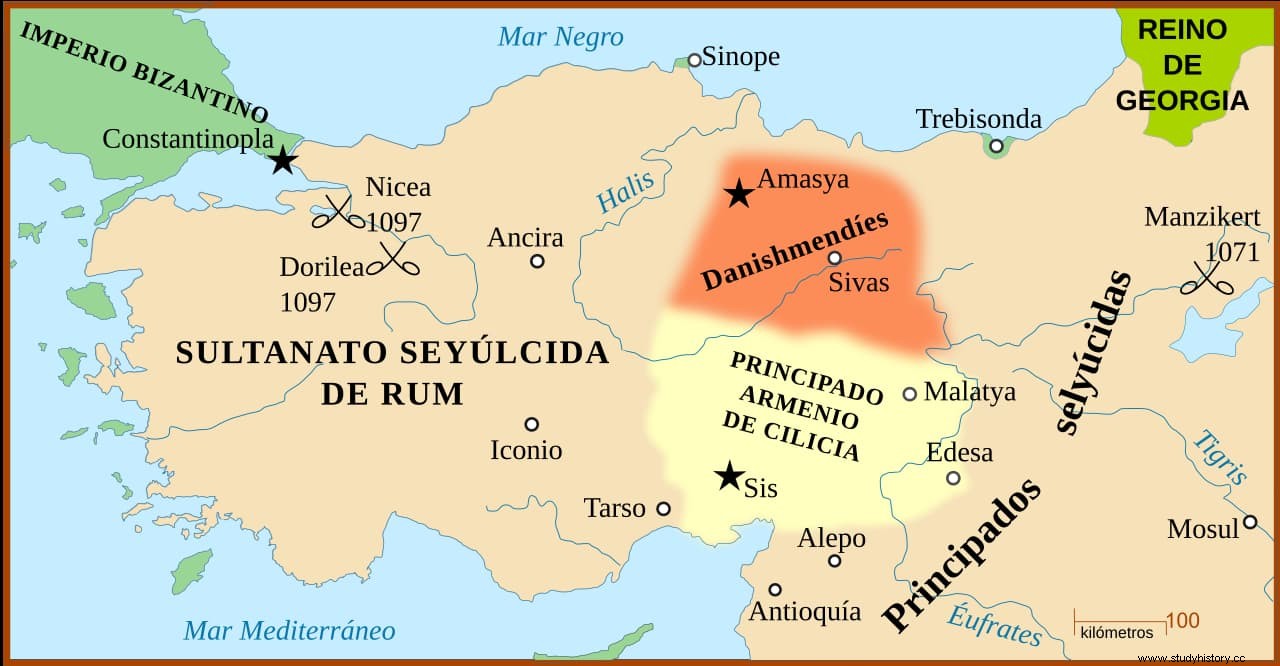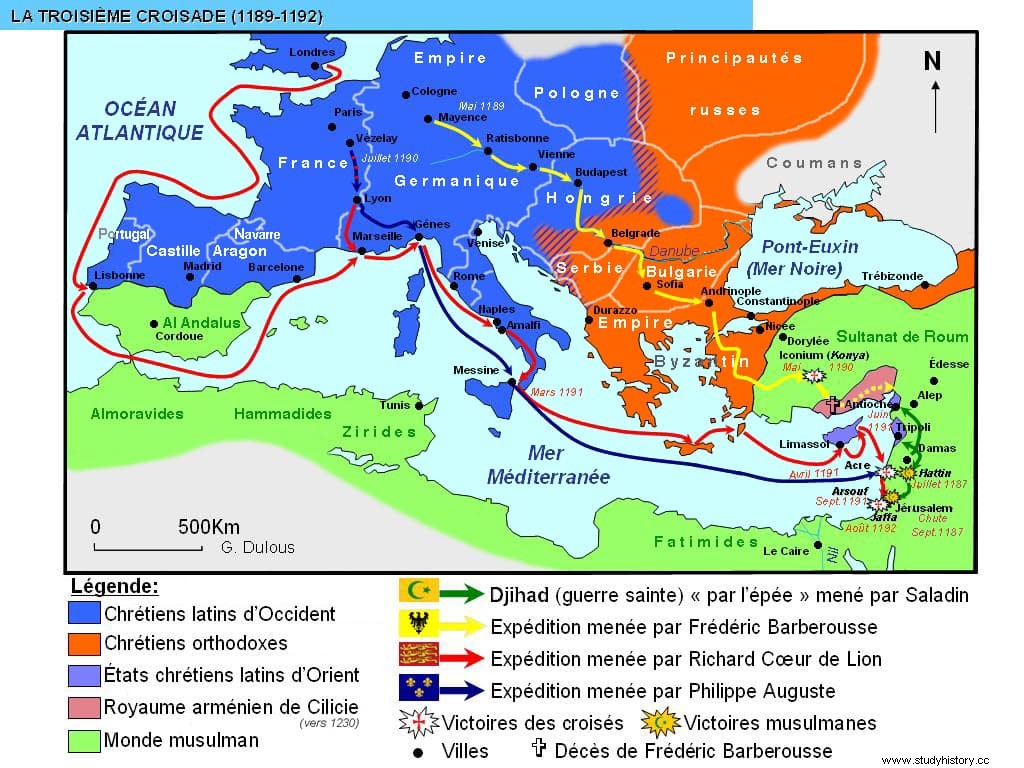Although the classic image of the crusaders is that of heavy knights, with their chain mail, strong chargers, closed helmets and lances at the ready, in reality the image was more varied, with infantry and light cavalry. In the latter, some special warriors were framed who used less protection than the others and used to fight with lighter spears or, above all, bows and arrows. Its main characteristic was that it had a mestizo origin, a mixture of Greek and Turkish, in principle Christian, although in practice Muslims were also recruited. They were the Turkopoles.
The etymology of the word is Greek:tourkopoulos means son of Turk. To be exact, they were descendants of Seljuk Persians and Hellenes, therefore with an ancestry that, at least on one hand, had links with the West and, given the dates in which they already had to live, the majority professing the Orthodox Christian faith (of In fact, there were also followers of the Syrian Church of Antioch, although probably in that case it was an extension of the term to people of arms or even simple servants). Many of them lived in various regions of Anatolia and spoke Turkish, which leads some historians to consider them ancestors of the Karamanlides, Anatolian Greeks who used that language orally but wrote it in Hellenic characters.

However, another part was made up of converted Muslims, hence in the crusades they were considered apostates and therefore the enemy executed them immediately when they were captured. There were even those who kept their Islamic religion and were hired as mercenaries. In any case, the Christian faith and their skill as warriors were powerful reasons for the Byzantines to incorporate them into their army. Later, when the First Crusade was proclaimed, the crusaders who arrived in Constantinople discovered their usefulness as light cavalry and took them with them to the Holy Land.
In campaign, the turcópolos carried out tasks of exploration, harassment and support. For this, we said before, they used lighter equipment than that of heavy cavalry. Their horses were smaller in order to prioritize agility and speed, while the horsemen dispensed with chain mail to wear gambeson (a quilted linen or cotton doublet stuffed with equine hair that could be worn in combination with the mail or by itself). only) and conical steel helmet (open, to facilitate vision). The weapons were varied but in the style used by the Seljuk Turks, with a light spear, a hand weapon (single-edged sword, mace...) and a small shield and bow with arrows; in fact, most sources describe them as mounted archers, although they could also fight on foot.
To the cry of “Deus vult!” (God willing!), the First Crusade was called by Pope Urban II in the year 1095 in response to a request for help from the Byzantine Emperor Alexios I Komnenos, who was threatened by the Seljuk Turks. After the failure of the so-called Crusade of the Poor, promoted by Pedro the Hermit , the supreme pontiff, who hoped in the process to reunite the two branches into which Christianity had been separated (Catholic and Orthodox), managed to gather an army of knights from the European feudal nobility, totaling some 35,000 troops. The meeting point was Constantinople, where they incorporated the Turkopoles to leave for the Holy Land.
Apparently, it was the Byzantine general Tatikios who was responsible for adopting such horsemen. He was the son of a Turk captured by John Comnenus and grew up with Alexius I, whom he saved from an ambush in 1078 by his rival for the throne, Basilacius, when he was not yet emperor. For this he was promoted to the position of great primicerius and he became a general, leading campaigns against the Seljuks and the Cumans. He later participated in the First Crusade leading auxiliary corps, including the Turcopoles and a sizeable contingent of Peltasts (light infants).
The conquests of Nicaea, Antioch and Jerusalem allowed the creation of a Christian kingdom in those latitudes with Baldwin of Edessa as the first titled monarch in 1100. But that did not prevent the disunity between the various leaders, which favored the proclamation of a jihad and the need to organize a second crusade in 1144 to stop it. This failed in its attempt to besiege Damascus and was also the scene of the emergence of Saladin, who in 1187 took Jerusalem, causing the Third Crusade. By then the most important religious orders of chivalry had already been founded, justified by the need to care for and protect pilgrims.
The first was that of the Holy Sepulcher (1099), followed by the Hospitaller of San Juan (1104), Temple (1118), San Lázaro (1142) and many more in each European country. The hospital knights began dedicated to taking care of the hospitals and after the fall of Jerusalem they extended their functions to the military. On the other hand, the Templars, like those of the Holy Sepulcher, were instituted from the beginning as a protection body for pilgrims and if initially there were only nine fratres milites (knights), in a short time they formed a fearsome army. One and the other - the Hospitallers before anyone else - incorporated the Turcópolos as an auxiliary force.

As such, they constituted the bottom of the ranks, hierarchically inferior to sergeants or simple men-at-arms, to the point that they did not have the right to eat at the same table as regular members of the order; against them, instead, they received a salary (which was not too high due to their limited equipment). They were under the command of a turcopolier , that in combat, yes, he could surpass the sergeants in command and that with time he would become chief of the auxiliary cavalry. Likewise, the Grand Master had a Turkopolo among his assistants to serve as an interpreter before his own -remember that they spoke Turkish-.
The participation of the Turkopoles in the Third Crusade reached its climax in the Battle of the Horns of Hattin, in which Saladin's troops surprised the Christians -mainly Templars and Hospitallers- advancing through the Palestinian desert. Encircled, the crusaders tried to fortify themselves on a hill because most of the soldiers were on foot, having killed their mounts, but that position was a death trap, being sheer on the other side and lacking water. About two thousand knights and the scarce half a thousand of the four thousand original Turcópolos, decimated little by little during the march by covering the rear, tried to break the encirclement but could not. The intrepid light horsemen were massacred and those who survived were put to the sword for denying Islam.
At that time, the military orders no longer limited their presence to the Holy Land but spread throughout Europe, where they had enemies to fight in the form of heresies (or even Muslims much closer, as in the Iberian Peninsula), and new orders arose. (the Teutonic, the Livonian Brothers, Alcántara, Santiago…). The definitive loss of Jerusalem in 1244 and, above all, Acre in 1291 at the hands of the Mamluks, led the Christian world to have to give up its precarious domain and abandon the region. Including the military orders, which were no longer needed there.
The Templars settled in Cyprus and the Hospitallers in Rhodes first and Malta later. their goal now was to control the eastern Mediterranean and they took the Turkopoles with them. Since then, these and other orders officially established the position of turcopolier or, as in the Teutonic case, turkopolen , lasting several centuries. As late as 1568, during the Siege of Malta by the Ottomans, the presence of a turcopolier is recorded among the defenders, the Knights of Saint John (formerly Hospitallers).
And a curiosity to finish:in his studies on the peninsular Templars, the archivist and teacher Laureá Paragolas y Sabaté reports the presence of a certain Berengar el Turcópolo in some letters of the order dated in Tortosa between 1229 and 1234. Likewise, there are also references in the historical bibliography on the Crown of Aragon:The Kings of Aragon in historical annals (Pedro de Abarca), Expedition of the Catalans and Aragonese against the Turks and Greeks (Francisco de Moncada), Catalan Chronicle (Ramón Muntaner), etc.
